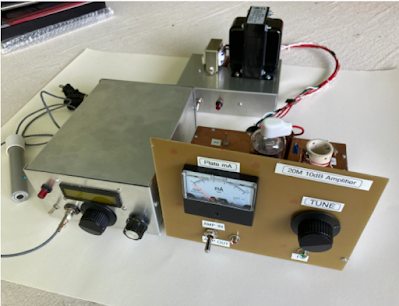SolderSmoke Podcast #262 is available:
Audio only: http://soldersmoke.com/soldersmoke262.mp3
Video: https://www.youtube.com/watch?v=QSUyE4IaHFw&t=61s
Intro:
-- We are over 100 on the Direct Conversion Receiver Builds. We talked about the receiver project at the GQRP convention. Video on the blog.
-- G4 Geomagnetic storm November 11-12. Messed up my computer. Blackout in the DR?
Pete:
-- USMC Birthday. Having served alongside them they have my deepest respect. Veterans Day.
-- Think about supporting those without a job this Thanksgiving. Cash to various organizations is best.
-- 50 Hz off frequency -- What does that mean if you tune by ear and not by mouse/waterfall?
-- The Hybrid Wireless is on the air. A unique build and not often seen.
-- Progress on the HOMEBREW MOSFET amplifier. Claude helped.
SHAMELESS COMMERCE DIVISION: Mostly DIY RF. Become a SolderSmoke Patron. Buy stuff from Amazon through the link on this blog (in the right side column).
Bill:
-- Preping for VHF in HI7. Can I kerchunk Boricua repeaters with Tropo? See: https://soldersmoke.blogspot.com/2025/09/puerto-rico-dominican-republic-tropo-on.html
-- Bill's mixer obsession. Grayson's HSD Chapter 12. The importance of knowing "the paticular go of it." EMRFD Chapter 5.
-- The new look for the SolderSmoke blog.
MAILBAG:
-- Todd VE7BPO -- Doing well.
-- Grayson KJ7UM on the loss of Jim Tonne W4ENE. Gone, but through his writting, continuing to contribute.See: https://web.archive.org/web/20220429224036/http://tonnesoftware.com/appnotes/demodulator/EnvelopeDemodulators.pdf
-- Camden is a 23 year-old blind ham who is looking for some homebrew help. He lives in Pleasant City, Ohio, about an hour east of Columbus. Can you help him? camden@bopp.net
-- Dale Parfitt into the QRP Hall of Fame! The Radio Gods Approve!
-- Paul VK3HN -- Bricolage, Cacharreo, Artilugio, and Jugaad. SA612 going obsolete.
-- Mike WN2A Mixers and all that. Tropo. "Greetings from the National Radio Noisy Zone!" (NJ)
-- Peter Marks VK3TPM -- SolderSmoke template help -- Digital HF Voice
-- Walter KA4KXX -- A great book by L.B. Cebik
-- Bob KD4EBM -- The Bob Pease Analog Troubleshooting book. Pease quote: "My favorite programming language is solder,"
-- Cor PA3COR Difference between mixers and adders
-- Mike WA3O I still have his HW-7. Amazing water-cooled amplifier. VK3MO.
-- Samuele IU2QBW An Italian Homebrewer https://soldersmoke.blogspot.com/2025/10/a-wonderful-homebrew-direct-conversion.html
-- Pil Joo VA3GPJ Experimenting with TIA amps.
-- Farhan VU2ESE -- USB and LSB LC filters -- Applicable for crystal filters too?
-- Rogier PA1ZZ Thanks for the great videos!
-- Captain Mike KX4WC Aeronautical Mobile --Santiago, Chile to Panama! With Mike WA3O and Ian VK3MO: https://soldersmoke.blogspot.com/2025/11/vk3mo-and-wa3o-brotherhood-of-ham-radio.html
-- Dave AA7EE A completely AI SolderSmoke? "Open the pod bay doors Hal."
-- Pat W3RGA heard my 1 watt HI7 beacon. Thanks Pat.
-- Patrick Voets -- A Belgian living in the Netherlands -- supports our defiant NIMCEL position!
-- Brian "Moses" Hall K8TIY, Father of Robert of "Crank it in Robert" fame. Check out the video. Young Robert appears around the 45 minute point: https://youtu.be/Xqs2Ihucr6I?t=2730
-- Will Harris KI4POV -- an esteemed homebrewer -- asks about using 75 ohm coax. I say yes, Pete tells him how to do it right.































